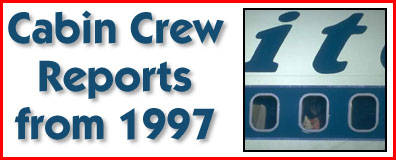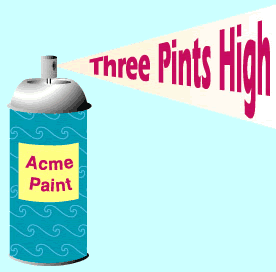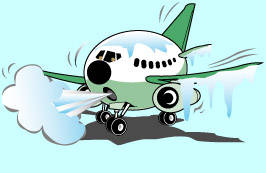
In
1997 ASRS introduced two new reporting forms, for maintenance and cabin
crew personnel. This month we share some of the reports ASRS has received
involving cabin crew. A disturbing number of these described serious incidents
of passenger misconduct and abuse of crew members. Our first few report
excerpts involve that seat of many passenger transgressions--the lavatory.
Booze and
Blues
In the following incident,
the passenger in question appeared to be fine during boarding, but trouble
began after he awakened from a nap:
- About
45-50 minutes after takeoff, we had a passenger who was sleeping,
wake up screaming and pointing at no one. He locked himself in the
aft lavatory and started to bang on the walls and continued to scream.
I opened the door and told him his behavior was not appropriate nor
would it be tolerated. He told me to go away or he would kill me!
The crew figured he was drunk and searched his bags where we found
a big bottle of [whiskey]. He was not served liquor on board. We finally
got him out of the lavatory--we were fearful he would hurt himself
in there. We had a minister who asked to help because the passenger
was crying and upset about something. The passenger over the next
hour became more belligerent and then violent--the passenger hit both
myself and the #3 Flight Attendant, threatening to kill us several
times. The First Officer helped us to restrain the passenger. He received
similar threats and...the minister who helped us was punched in the
face, again with the threats.
Because of the time of night, both myself and the #3 Flight Attendant
were able to spend time trying to contain this passenger. We both
had to suspend our normal duties including our normal jumpseats for
landing. I feel other passengers were upset and fearful. We were met
by police and the passenger was removed.
ASRS learned from a callback
to several cabin crew members who reported this incident that a company
report was filed about the disturbance. The FBI also investigated the
incident, and a crew member pressed charges against the disruptive passenger.
Bodies
Double
- I was
working First Class Galley. The flight was oversold and the agents
were very concerned about an "on time" departure. We had
one additional crew member deadheading and one extra cabin attendant
deadheading. It was after the seat belt sign came off that our extra
cabin attendant deadheading came up and told us we had a stowaway
in the aft lavatory. We had a briefing with the Captain and the additional
crew members... The Captain made radio contact and we continued on
to destination...
[The stowaway] was just out of a rehabilitation center for drugs...
His eyes were dilated and he was nervous... A deadheading Captain
and another pilot watched the stowaway during our service and kept
him occupied. I kept him out of First Class and the cockpit. We "parked"
a crew member near him at all times. We kept him in the rear of the
aircraft for landing and during deplaning until the proper people
could remove him... Since boarding cards are no longer checked, and
an "on time" departure is so important--it puts pressure
on everyone--rushing can lead to human error... In the future, someone
should be assigned to check lavatories prior to closing of the door.
 A
flight crew reported that the discovery of hazardous materials ("hazmat")
carried on board by a passenger caused them to do some soul-searching
afterwards about their handling of the incident.
A
flight crew reported that the discovery of hazardous materials ("hazmat")
carried on board by a passenger caused them to do some soul-searching
afterwards about their handling of the incident.
- [From
the Captain's report] Flight Attendant notified us of a passenger
who had brought aboard 3 pint cans of acetone-based paint, one of
which leaked to some extent inside his carry-on bag. The Flight Attendant
mentioned a "nail polish remover" odor, and the passenger
said, "Oh! that must be my bag." Inspection of his bag indicated
a small amount of paint had seeped from the can to the inside of the
bag. The Flight Attendant secured all 3 cans in protective plastic
bags. The odor went away and there were no reports of any passenger
either noticing the odor or experiencing adverse physical effects.
Company procedure for a paint or flammable liquid spill calls for
notification of ATC, Fire/Rescue resources, Hazmat response teams,
and station personnel. Since the situation was quickly discovered,
and completely and thoroughly met by the Flight Attendant, the First
Officer and I concluded that to activate such resources was not justified...
I feel this situation served as a warning to us all to at least reexamine
the effectiveness of passenger screening...
[From
the First Officer's report]
No matter how minimal a hazard our situation appeared to be, we may
have neglected to take the most serious precautions necessary to protect
the safety of our flight. I feel that there is not enough education
of the public on hazmat and air travel.
 Ice
can take its toll on aircraft on the ground and in the air, leading
to less-than-satisfactory conclusions to planned flights. A Part 135
cargo pilot reports that a fast approach and a short, icy runway is
not a good combination.
Ice
can take its toll on aircraft on the ground and in the air, leading
to less-than-satisfactory conclusions to planned flights. A Part 135
cargo pilot reports that a fast approach and a short, icy runway is
not a good combination.
- I was
prepared for and cleared for a straight-in approach. I didn't break
out until over the airport, so I requested to circle, but I botched
the request. I wanted the long runway, 21R, but requested 21L and
accepted the clearance to land there. It was only 3,000 feet long.
I didn't bleed off [my airspeed] due to icing and a lower-than-normal
glide path. So I landed 700-800 feet down the runway, and although
I used maximum braking, I slid off the end of the runway. I didn't
get stuck and no damage was done...
I briefed myself for an approach to the long runway, then accidentally
switched, spur of the moment, to a short runway. Bad choice.
Another Part 135 cargo flight,
this time in a corporate jet, encountered ice problems in-flight, and
endured a much more costly incident. The Captain reports:
- On our
descent through 12,000 down to 6,000 feet, we picked up moderate-to-severe
icing. Icing equipment was on, nacelles heat on, wings and stabilizer
heat on. We did a missed approach, and picked up more icing to about
12,000 feet. Leveling, both engines flamed out within about five seconds
of each other. It took two minutes to restart them. We proceeded to
our alternate airport.
Most likely cause was ice ingestion. [Maintenance] replaced the right
engine--bent blades on the first stage [compressor]--and "dressed
up" the left engine--several nicks.
Each aircraft type has its
own icing characteristics, but most require the anti-ice equipment to
be turned on before encountering icing. Ice that adheres
to some unprotected sections of the aircraft may shed suddenly, as was
apparently the case in this incident. Ice may also persist long after
the aircraft has departed icing conditions.
Not
Quite Enough...
Well before an aircraft leaves
the ground, icing needs to be given serious consideration. An air carrier
Captain tells how long delays for weather, resultant schedule pressure,
a nighttime departure, and a possibly inadequately-trained ground crew
combined to set the stage for a potential icing disaster--averted by
two sharp-eyed passengers.
- We had
waited for threshold deicing for 3.5 hours. I told the deicer that
I wanted the entire aircraft deiced and the engine inlets checked
for contamination. After about 20 minutes, the deicer returned to
the interphone to advise me that the aircraft was clean. After starting
the left engine, I was called by one of the Flight Attendants, and
was told that a passenger as well as a deadheading Flight Attendant
had noticed that the wings were still covered with snow and ice. We
shut down the engine, and recalled the deicer...to respray the wings.
I also had the First Officer perform a cabin inspection, and he also
confirmed that the inboard third and aft half of the left wing contained
large areas of snow and ice. It is apparent that standard phraseology
of "Your aircraft is clean" does not insure the level of
safety required.
Had it not been for an observant flight attendant and passenger, our
takeoff might have been jeopardized.
The First Officer's report
concludes that standard procedure should include a visual inspection
of the aircraft by a cockpit crew member after the deicing process.
Although it is not a requirement, many pilots already follow this sage
advice.
A pilot reports that her
small twin-engine aircraft was deiced prior to takeoff on a snowy IMC
day, but that the deicing process created a whole new problem.
- Preflight
and before-takeoff checks all normal. Only thing out of the ordinary
(or not so out of the ordinary for this aircraft) was that the heater
would not ignite while holding short of the runway, and it had while
[repositioning earlier]. Radio reception caused me to ask how Tower
heard me. Their readback was loud and clear, so I assumed all was
normal, perhaps just my position or this particular radio.
After becoming airborne, I did not receive any further radio transmissions.
I tested both radios--nothing. I began a turn back towards the airport,
but had lost sight of it, so began the lost communications procedure
for the XYZ Departure. Then I noticed no navigation equipment. I went
to squawk 7700 and noticed no transponder. Then I looked and saw no
electrical. Big problem because of lack of familiarity [with the area].
[After circling], I relocated the field and landed. I followed the
airport manager [to taxi] back to base.
Postflight inspection found excessive amounts of deicing fluid everywhere--alternators,
aft compartment where battery is located, engine nacelles, etc.
It was later determined that
more than 76 gallons of deicing fluid had been used to deice the aircraft.
The initial heater and radio problems were ignored because the aircraft
had some history of electrical "glitches," but the reporter
states that such glitches will not be ignored in the future.



 A
flight crew reported that the discovery of hazardous materials ("hazmat")
carried on board by a passenger caused them to do some soul-searching
afterwards about their handling of the incident.
A
flight crew reported that the discovery of hazardous materials ("hazmat")
carried on board by a passenger caused them to do some soul-searching
afterwards about their handling of the incident. Ice
can take its toll on aircraft on the ground and in the air, leading
to less-than-satisfactory conclusions to planned flights. A Part 135
cargo pilot reports that a fast approach and a short, icy runway is
not a good combination.
Ice
can take its toll on aircraft on the ground and in the air, leading
to less-than-satisfactory conclusions to planned flights. A Part 135
cargo pilot reports that a fast approach and a short, icy runway is
not a good combination.